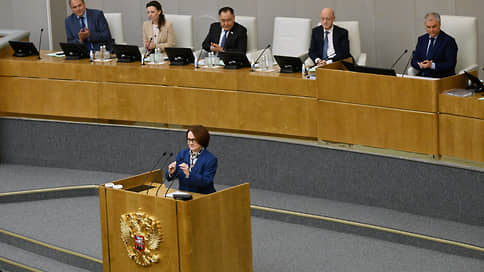The head of the Central Bank Nabiullina explained to the State Duma the reasons for maintaining a high key rate
[ad_1]

A reduction in the key rate is hampered by the continued risk of economic overheating due to high demand; against this background, Russian GDP continues to grow at a high rate. Such statements were made in the State Duma on Wednesday by the head of the Central Bank, Elvira Nabiullina, who presented the regulator’s annual report to the chamber. From the data of the Central Bank it follows that, despite high rates, in the corporate sector the growth rate of lending accelerated in February, while in the retail sector only the increase in mortgage issuance decreased. In addition to internal reasons to keep the rate high, there are also external ones – in conditions of non-growing exports, an increase in imports inevitably leads to a weakening of the ruble.
“In the fall, there were many fears that raising the key rate would put an end to economic development. But we see that this is not the case,” the head of the Central Bank, Elvira Nabiullina, reassured parliamentarians when she spoke in the State Duma on Wednesday with a report for 2023. According to her, operational indicators show that the economy continues to grow at a strong pace in the first quarter of this year, and business optimism rests on their rising expectations of demand for products.
To defend the need to maintain a high key rate (remember, it is now 16%), the head of the regulator, for the sake of better understanding, resorted to a comparison with a marathon race.
“Demand growing too quickly forces the economy to run faster and faster, and for some time it can run at its limit,” she explained. It takes time to increase supply in the markets, but the lag of production from demand not only increases prices, but also shifts demand to imports. “Imports require currency, and if exports, as in our case, do not grow, then increased demand inevitably leads to a weakening of the ruble,” added Elvira Nabiullina. The peak of inflation in the Russian Federation, according to the regulator, is already behind us – the annualized price growth rate was double-digit from July to November 2023. In December 2023 – January 2024, it slowed down to a level of about 6%. If the previous rate were maintained, inflation would continue to accelerate even now, the Central Bank is confident.
According to Rosstat data released on Wednesday, in March consumer inflation in annual terms amounted to 7.72% (in February – 7.69%), while monthly price growth slowed from 0.68% to 0.39%, and with the clearing of seasonality – from 0.51% to 0.27%. The rate of growth in prices for food products decreased from 0.77% to 0.17%, for non-food products they remained at the February level, and in the service sector they decreased slightly.
Among the additional arguments in favor of a high rate, Elvira Nabiullina pointed to the factor of protecting the real incomes of citizens (and their savings – the influx of funds on deposits continues, in the second half of the year interest on them amounted to almost 1 trillion rubles), as well as the stabilization of the ruble exchange rate.
So far, the reduction of the key rate, according to the logic of the Central Bank, is hampered, among other things, by a noticeable increase in budget expenditures: budget policy is making a higher contribution to aggregate demand than before – through government orders, through public investments, wage growth, preferential loans, direct subsidies (note that that in March, according to the latest data from the Ministry of Finance, at the end of the “advance season”, budget expenditures compared to February decreased noticeably – from 4 trillion to 2.8 trillion rubles, see “Kommersant” for April 9). The head of the Central Bank explained that in order for an increase in government spending not to lead to a constant acceleration of price growth, the space for private credit should decrease. “And this means that monetary policy must be tighter,” added the head of the Central Bank.
The rate cut, she said, will begin when the regulator is confident that the slowdown in inflation has reached the desired speed and inflation expectations are returning to normal.
Due to inflation, companies face rising costs, and this factor is more significant than a temporary increase in interest payments. Lending volumes, despite high rates, have so far declined only moderately, and in March activity in retail lending increased slightly, as follows from the Central Bank’s commentary on monetary policy published the day before. The growth of the corporate portfolio at the end of February accelerated from 0.2% in January to 0.7% (the annual growth was 19.9% versus 21.1% a month earlier). The volume of retail loans issued in February increased by 23.3% year-on-year versus 23.5% in January, while the volume of unsecured consumer lending did not decrease – month-on-month growth remained at 0.9%. The car loan portfolio continued to grow (3.9% versus 21.2% in January). A slowdown is noted only in the issuance of mortgages – the portfolio of such loans grew by 0.4% in February compared to 0.7% in January, while the annual increase was 28.7%.
Let us remember that the Central Bank cites preferential mortgages as an example of how the market is heating up with cheap lending – it leads to higher prices for housing and an increase in the debt load of citizens. Over the past two years, the share of mortgages issued to individuals with a high debt burden has increased by one and a half times, and in the fourth quarter of last year, almost every second borrower (45%) received a mortgage with the prospect that he would have to spend more than 80% of his income on payments.
[ad_2]
Source link






